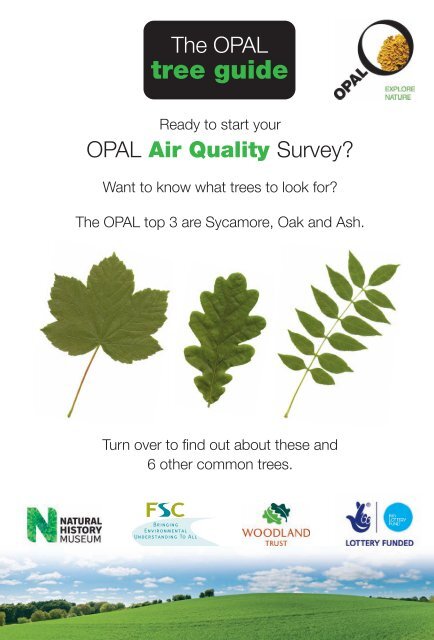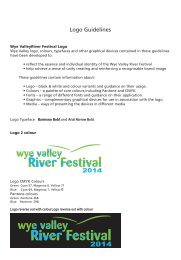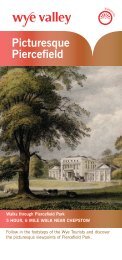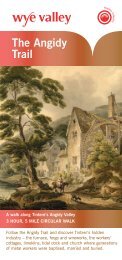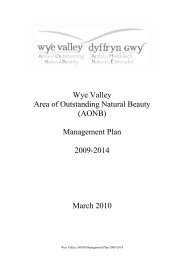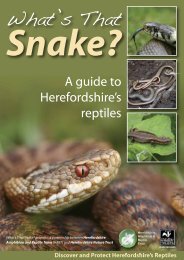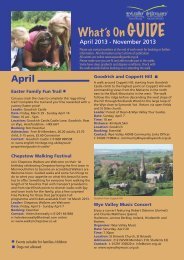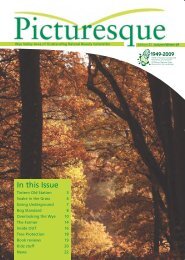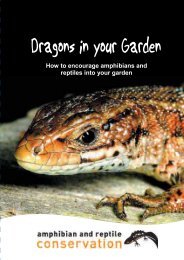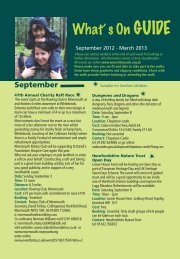Tree guide - Opal
Tree guide - Opal
Tree guide - Opal
You also want an ePaper? Increase the reach of your titles
YUMPU automatically turns print PDFs into web optimized ePapers that Google loves.
The OPALtree <strong>guide</strong>Ready to start yourOPAL Air Quality Survey?Want to know what trees to look for?The OPAL top 3 are Sycamore, Oak and Ash.Turn over to find out about these and6 other common trees.
Sycamore – Acer pseudoplatanusLeaf has 5-lobesand a toothed edge.Look for paired, winged‘keys’ (often calledhelicopters) hangingfrom the tree in thesummer and autumn.Black spots on leavesare likely to be theTar Spot fungus.Oak – Quercus speciesLook for acorns on thetree and on the groundunder the tree.Ash – Fraxinus excelsiorPaired ‘leaflets’ withuneven edges on agreen stalk.Big black buds onthe twigs.Look for bunchesof single-winged‘keys’ on the treefrom autumn tospring.
Cherry– Prunus speciesThe brown or redbark has paperystrips that peelhorizontally.Beech– Fagus speciesLook for triangularnuts or their pricklycases on the tree oron the groundunderneath it.Rowan (Mountain Ash)– Sorbus aucupariaPaired ‘leaflets’ withtoothed edges on ared stalk.Pale buds on thetwigs.Look for redberriesin theautumn.
Lime – Tilia speciesHeart-shaped leaf thatusually bulges moreon one side of theleaf stalk thanthe other.leaf stalkBirch – Betula speciesLook for smooth bark,usually white or grey(rarely brown) –on older trees therewill be dark splitsand cracksin the bark.Horse Chestnut– Aesculus hippocastanumFat, often sticky budspaired on twigsLook for conkersin the summerand autumn.
More about tree identification<strong>Tree</strong>s can be divided into two main types – those with flat and wide leaves (broad-leaved) andthose with needle-like leaves (like Christmas trees). Most broad-leaved trees lose their leaves inautumn and grow new ones in the spring.One of the easiest ways to identify a tree is by its leaves and twigs. To use this <strong>guide</strong>, look at theleaf and twig shape on your tree and see if you can match it to the pictures.Start by looking at the shape of the leaves. Is it a single ‘solid’ leaf, is it lobed, or is it divided intoa number of leaflets, all attached to the same leaf stalk (a compound leaf)?‘solid’shapelobesleafletsleafstalkleafstalkSingle leavesCompound leavesLook at the twigs and compare the shape and colour of the buds to the pictures. Look out forfruits on the tree or on the ground underneath it, as this can help you confirm your identification.If your tree looks different to the pictures and you do not know its name, just enter the tree nameas ‘unknown’.To complete your survey don’t forget to enter your results on the OPAL website:www.OPALexplorenature.orgLearn more about trees – download a free bumper treepack stuffed with over 50 ideas and activities at theWoodland Trust’s nature detectives website:www.naturedetectives.org.uk/download/treesThis <strong>guide</strong> was developed by the Natural History Museum and Field Studies Council in partnership with the Woodland Trust.Photographs of leaves and twigs supplied by the Woodland Trust, fruits by FSC.


